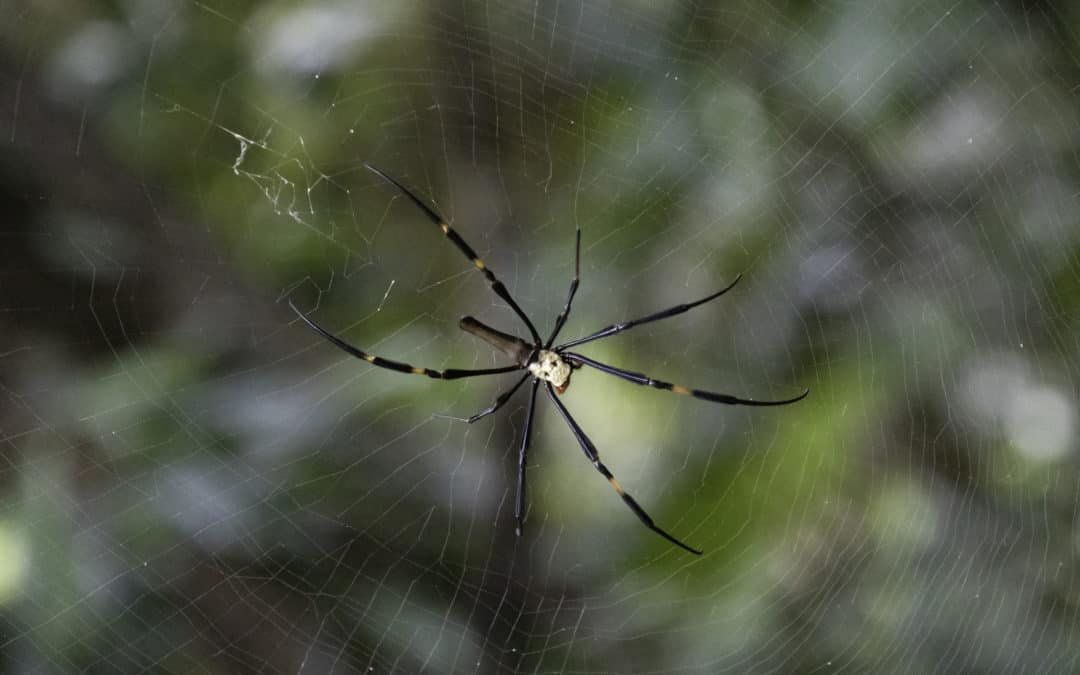Orb weaver spiders, also known as garden spiders and banana spiders, are actually a group of spiders belonging to the family Araneidae. This family is one of the most diverse in the world and contains many different species of spiders. Common throughout the world, orb weavers can be quite intimidating in appearance; but the main question is are orb weaver spiders dangerous or not? Let’s take a closer look at the orb weaver, as well as some ways to prevent them.
Appearance
Orb weavers can grow to be quite large, ranging in size from 6 mm to 20 mm. Like all spiders, they have a cephalothorax (where their thorax and head are fused together), an abdomen, and 8 legs. They also have chelicera, which are fang-like mouthparts. They also have large abdomen that can actually overlap their thoraces, and hairy or spiny legs. Most nocturnal orb weavers are brown or gray in color while diurnal species are usually bright yellow or orange with their trademark black markings.
Habitat
Orb weavers are found throughout the world except Antarctica and the Arctic. In North America there are 180 species alone. These spiders usually inhabit locations that have an abundance of animals they can prey upon, along with structures that can support their webs. They are commonly found around night lights, tree branches, tall grass, fences, walls, bushes, and weeds.
Diet
Orb weavers feast on small insects like flies, beetles, wasps, moths, and mosquitoes. Larger spiders will even eat small frogs and hummingbirds.
Reproduction
Male orb weavers are much smaller than females and their sole purpose is to mate with females. Once they have mated, males are often the first meal for females. Females will produce one or more egg sacs that contain several hundred eggs per sac.
Behavior
Orb weavers are most notable for the large webs they create. These webs are circular in shape and highly organized with several radial strands of silk that look like wagon wheel spokes that are connected by concentric circular strands. These webs can measure up to 3 feet in diameter! Orb weaver spiders are typically nocturnal, building and repairing their webs at night.
At dawn, some orb weavers will tear down their webs and eat them to take in moisture from the dew that collects on them and to prevent larger animals like birds from becoming trapped in them.
Orb weavers aren’t hunters or wanderers and stick pretty close to home. They usually sit inside their webs and wait for prey to be trapped. Occasionally they will hide nearby and leave trap lines that vibrate when the web has been breached. Once something has been trapped in the web, the spider will bite and paralyze it and wrap it in silk to eat later.
Orb weavers are usually spotted around homes and gardens in late summer and fall.
Risk
Orb weavers aren’t considered a significant threat to humans. In fact, they are considered beneficial to have around as they consume pests like mosquitoes and beetles that can cause problems for you and your plants. These spiders are not aggressive and rarely bite unless they are threatened and cannot escape. The bite of an orb weaver is often compared to a bee sting and there are no long lasting effects from their bite. They are quite harmless unless their web is built in a location that is frequented by people.
Prevention
Although orb weavers are considered harmless (and even beneficial) some people just don’t like the idea of a creepy spider hanging around their home. Decreasing the population of other insects around your home that they can use as a food source will help deter them from hanging around and send them off somewhere else in search of food. Sealing holes, cracks, and gaps in the exterior of your home helps eliminate entry points for them indoors. Removing ground litter and other items they can use for shelter or harboring will also keep them from taking up residence in your yard.
If you have a problem with spiders or any other pests in or around your home, you can always contact a professional pest control company who can provide you with a free inspection to help you identify what type of pest you are dealing with and set you up with the appropriate treatment and prevention plan for your situation.
You May Also Be Interested In:
Fire Ants: Still Active in Fall?
Nuisance Pests and How To Control Them

